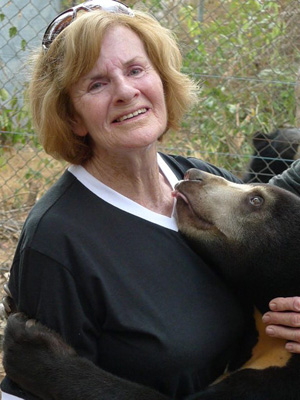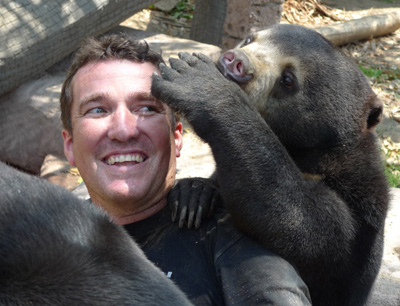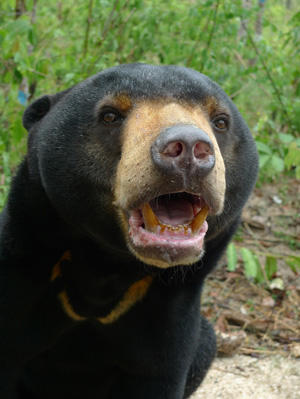Rally to the claws
Conservationists are working tirelessly to save Asia’s bears from the cooking pot
Tibor Krausz
South China Morning Post, January 8, 2011
Phnom Tamao
Holly loves living it up. Frolicking in a pool, the young Asiatic black bear swipes playfully at the water. She then ambushes one of the four cubs that share her spacious enclosure and wrestles her to the ground.

“Each bear has a huge character bursting to get out,” says Matt Hunt, Southeast Asia director of Free the Bears Fund, a Perth-based charity that runs this ursine sanctuary in rural Phnom Tamao, 40 kilometres south of the Cambodian capital, Phnom Penh. “It’s amazing to watch animals that arrive here terrified and emaciated shivering in a corner come alive and throw themselves headfirst into play,” he adds.
Holly arrived at the refuge centre in October 2008 after wildlife officials confiscated her in the western province of Pursat.
“At the time of her rescue she was just a few months old,” Hunt says. “Probably, she had just left the den and started to follow her mother around the forest when her foot was caught in a snare.”
The cub had been kept in a cage outside a restaurant, where she was destined to be used for “bear paw soup”, a local delicacy costing around US$300 a bowl. With the bleeding stumps of her amputated limbs cauterised, she’d have been allowed to live just long enough to be dunked alive in boiling water for the benefit of wealthy patrons who prefer their bear meat “fresh.”
In Cambodia, as well as Thailand and Vietnam, restaurants illegally cater to wealthy local clients – and South Korean, Chinese and Japanese tourists – who enjoy pricey “emperor’s food” offered clandestinely.
“It’s very much in your face if you know where to look,” says Tim Redford, a wildlife expert at Freeland, a regional conservationist group based in Bangkok. “In places like Pattaya, you can have bear meat every day if you can afford it.”
Bears from Cambodia’s forests often wind up in Thailand, the trafficking hub of the regional wildlife trade, or in Vietnam. Highly prized as ingredients for traditional medicine, the animals are poached mercilessly, often with crude snares.
“Thousands of animals around the region are caught in snares each year,” says Nick Marx, a veteran field agent for the international conservationist group Wildlife Alliance. With his rescue team of local officials, Marx has sprung many animals from snares and captivity across Cambodia, from pygmy lorises to work elephants. “If the hunters do not return to check on the snares regularly, the animals often simply starve to death,” he says.
Yet despite their tribulations, Malaysian sun bears and Asiatic black bears, two closely related species indigenous to the tropics, are routinely overlooked in global conservation efforts. Chalk that up to “the Panda Effect.” While China’s endangered mascot can make headlines worldwide with just a sneeze, its cousins further south remain largely neglected. “I hate those bloody pandas,” Hunt quips indignantly. “It’s often as if no other bears even existed.”
In Vietnam alone, an estimated 4,500 bears are locked in tiny cages at “bear farms,” which, though illegal, continue to flourish as demand remains strong for bear bile as an ingredient in traditional medicine. The animals have crude catheters inserted through open wounds in their sides, into their gall bladders to drain their bile, as if on a tap.

Free the Bears Fund, which was set up in 1995 has managed to highlight the animals’ plight – and do something about it. In Phnom Tamao, Holly and the shelter’s other 113 black and sun bears live on the scenic grounds of a forested seven hectare refuge. Nosy and mischievous, they traipse aerial walkways, splash about in pools or doze in their dens. Even bears that lost a paw to crude snares have learned to climb again.
The charity operates similar shelters for hundreds of other bears rescued in Laos, Vietnam, Malaysia, Indonesia, Thailand and India.
“When we started here [in 1997] we didn’t even have a shovel,” says its founder, Mary Hutton, a grandmother in her early 70s who still runs the charity from her home’s converted garage. “We built an enclosure, then a nursery, then another enclosure,” she says.
In 1993, Hutton saw a television report showing an Asiatic black bear at a bear farm in China. “It got to me,” she recalls, “that distraught little bear banging its head against the bars of its cage.”
She drew up a petition, stood outside a shopping mall in Perth and began collecting signatures. Boosted by the widespread support she received, she bought a fax machine and set up the Free the Bears Fund. “Raffles, lamington drives, movie nights, collection tins; you name it, we did it,” Hutton says.

As Hutton’s drive became publicised, she says, “People started calling me up: Can you help this bear, that bear, the other bear?”
One call came from an expat in Cambodia, a country that to her back then “might have been on the moon”, Hutton says. He’d just bought three sun bear cubs at a Phnom Penh market in a bid to save them, but didn’t know what to do with them. So she “took a change of underwear, socks, and sunscreen,” and off she went. Over the years she would face culture shock, political upheavals and recalcitrant traders across the region as she went about saving and rehabilitating hundreds of needy bears.
Hutton is in Phnom Tamao on a visit to “thank keepers for their hard work” and catch up with work on the ground, which includes the opening of a new playhouse for cubs with a ceremony presided over by Buddhist monks.
While Hutton’s organisation focuses primarily on rehabilitating rescued animals, its mission also includes the education of locals about the importance of wildlife protection. The Free the Bear Express, a large brightly painted coach converted into a schoolroom on wheels, meanders around Cambodian byways and rutted narrow jungle dirt tracks from hamlet to hamlet, bearing a conservationist message.
The group is also engaged in economic projects for locals. It buys wild honey from subsistence farmers and provides them with needful things to wean them off poaching.
“Many locals are occupied with surviving themselves, so animals are not a priority to them,” says Choun Vuthy, a local keeper at the sprawling Phnom Tamao Wildlife Refuge Centre, which Free the Bears’ own sanctuary is part of. “But they’re slowly coming around to the view that wildlife protection is essential for their future.”